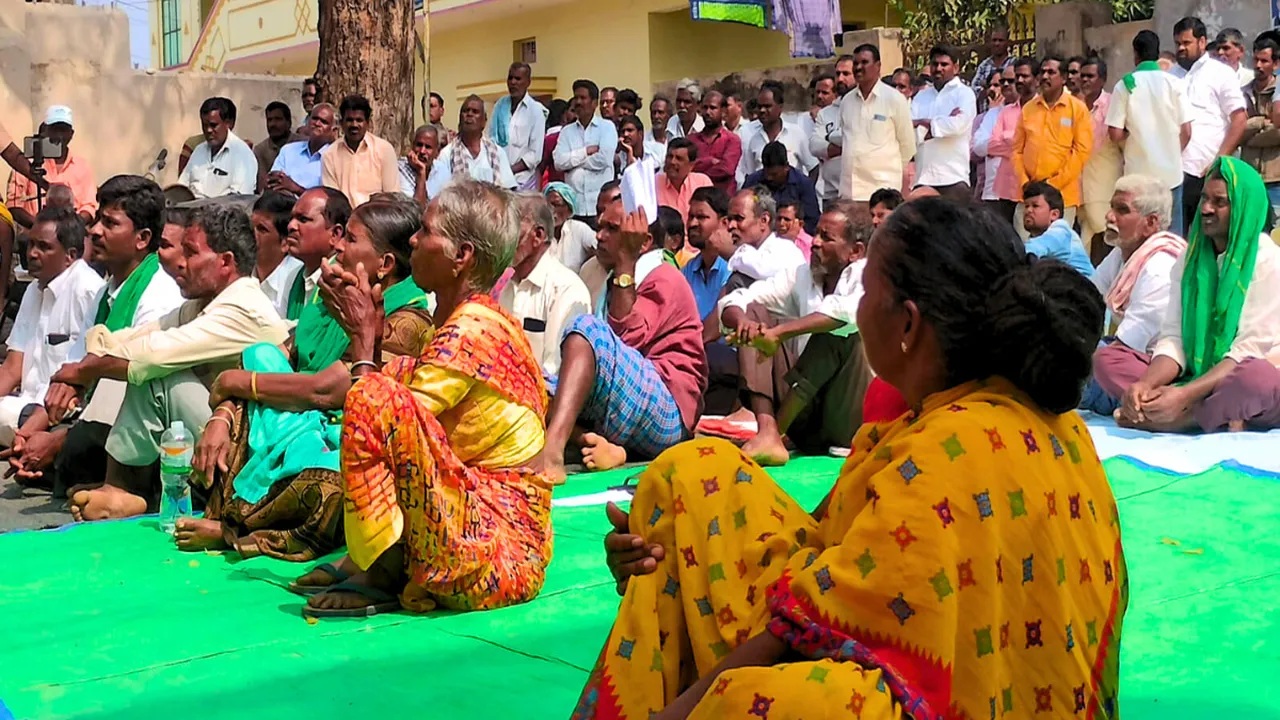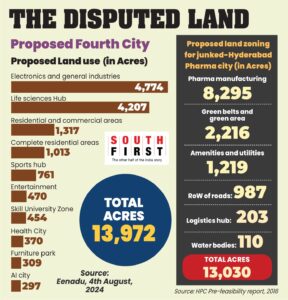The Government of Telangana cannot go against the established principles, procedures, and processes enshrined in the Indian Constitution, that protect people from insane, irrational, and unnecessary projects.
Published Apr 17, 2025 | 4:00 PM ⚊ Updated Apr 17, 2025 | 4:22 PM

Concerned members of the civil society joined farmers to protest against the Pharma City project in January. (File photo)
Synopsis: According to preliminary information, the Hyderabad Pharma City and/or Future City are likely to encircle the villages, leaving them stranded. The villagers’ access to the outside world, employment, and livelihoods are in jeopardy. The authorities concerned have not clarified these aspects.
Various pronouncements are being made about the development of the Future City (previously called the Fourth City) in and around the lands acquired for the Hyderabad Pharma City near Yacharam, Kandukur, and Kadthal mandals of Ranga Reddy District by the Telangana State Industrial Infrastructure Corporation (TDIIC) Ltd.
Telangana’s government’s recent actions, especially the notification of a Future City Development Authority, pose new challenges, complicating the legal environment surrounding this kind of development, besides adding to the mess created by the previous BRS government. Undoing them will take a lot of effort, which is required in the interests of the farmers in the area.
Apparently, the chief minister is being led on the garden path by TSIIC officials and the Department of Industries and Commerce about the utilisation of land acquired in the name of Hyderabad Pharma City, for the Future City. A haze is being created about the law, legal positions, farmers’ aspirations and the consequences of recent decisions to use the same plan of Hyderabad Pharma City, namely for the electronics industry, among others.
Earlier, the Union Ministry of Environment, Forest and Climate Change (MoEF&CC) gave its clearance to the Hyderabad Pharma City, despite glaring omissions that are not in sync with the Environment Protection Act and various statutes therein.
Given the assurances in the Congress Manifesto, 2023, on the Hyderabad Pharma City, local people expected the current government to correct these historical mistakes of the previous dispensation, primarily to protect the public interest, local livelihoods, environment, and ecology.
Since 2015, we have challenged this project and raised a number of objections, and took them to the attention of the authorities concerned at every stage of the environment clearance process. We never received any response to the questions and objections raised.
The project proponent, namely TGIIC officials among others, played a crooked role in denying the Telangana people their rights mandated by the Constitution.
The plan/map for the junked Hyderabad Pharma City was linear, as the government prepared a plan as per the pattern of land acquisition. There is no other linear industrial estate. As a linear estate, the distance between the farthest points could be 50 kilometres, while the width at some places can be a mere 1 kilometre.
It also surrounds villages without including them in the estate. Residents were told that their villages, including houses, would not be acquired, whereas their lands around the villages would be acquired for the industrial estate.
There was no response from the then-government and MoEF&CC on how they expect the villagers to live on an island amid industries, without any means of livelihood.
However, TGIIC and MoEF&CC suggested that villagers will be allowed to reach their homes through the industrial estate.
Pharma industries are water-guzzling units, requiring thousands of gallons of water. These units also release an equal amount of effluents. The proposed electronic industry is also similar in water usage and release of effluents. The electronics industry releases a lot of heavy metal-laden effluents, as well as solvents and other forms of air pollutants.
In terms of potential pollution, the pharma and electronics industries are almost similar.
 A detailed plan for the industrial estate was missing then and even now. Environment Appraisal Committee (EAC) of the MoEF&CC noted that the “Hyderabad Pharma City and surroundings primarily consists of first- and second-order streams and about 22 small static water bodies (including six notified water bodies), which form the natural drainage of the area”.
A detailed plan for the industrial estate was missing then and even now. Environment Appraisal Committee (EAC) of the MoEF&CC noted that the “Hyderabad Pharma City and surroundings primarily consists of first- and second-order streams and about 22 small static water bodies (including six notified water bodies), which form the natural drainage of the area”.
A 1-kilometre buffer zone for water bodies was recommended, which was later reduced to 10 metres, and completely removed in the final Environmental Clearance.
An EAC subcommittee observed that 10 villages will be affected by the project. However, there are more. At least 23 villages will be directly affected, and several others indirectly.
After prodding by the EAC, TGIIC gave an analysis of water requirement, wastewater generation, estimation of raw material and finished product, emission rate, etc. for 298 pharma industries. This was done without consulting the Telangana Pollution Control Board. Currently, this analysis is missing.
The now-junked Hyderabad Pharma City included pharma NIMZ (13,030 acres), Pharma City Township (1,593 acres), Pharma University (630 acres), and Pharma R&D and Ancillary Hub (4,080 acres), totalling 19,333 acres.
It is not known to the farmers and people the 13,972 acres — out of the 19,333 acres — on which the “Fourth/Future City” will come up, and the status of the remaining 5,361 acres.
Severe lacunae in the environment impact study, done by the Environment Protection, Training and Research Institute (EPTRI), were pointed out earlier. EPTRI is a government agency under the direct control of the project proponent, the Government of Telangana. There is a direct conflict of interest.
We have highlighted severe shortcomings in conducting public hearings. It was carried out by deploying the police, making preventive arrests, and preventing a larger number of villagers from airing their views. A public hearing impacting 232 villages was “completed” within four hours.
The Kadthal Reserve Forest, Mudhivennu Reserve Forest, and Tippareddypalli Reserve Forest have been listed as ecologically sensitive areas located within 15 km of aerial distance from the proposed area of the junked Hyderabad Pharma City.
In total, it has been mentioned that there are 13 reserved forests situated around the project site. A 100-m buffer zone between the forest and the project development area was proposed, which was further reduced to 60 m in the environment clearance without scientific study or validation.
There is no clarity on the type of industrial projects proposed in the area. Earlier, as per GO MS-31 dated 10 June 2016, “the proposed park will have components and other related activities at Pharma City including antibiotics, fermentation products, synthetic drugs, large volume chemical synthesis, intermediaries, vitamins, vaccines, drug formulations, nutraceuticals, herbal medicinal products, specialty chemicals, cosmetics among others. Efforts will also be made to establish a Research & Development incubation centre, central testing facilities, facilitating clinical trials, testing & certification, contract research & custom synthesis.”
However, the Common Effluent Treatment Plant (CETP) discussed is limited only to bulk drugs and formulations. The EAC has been misguided in this regard.
The estimated power demand was 900 MW for the Hyderabad Pharma City. TSIIC has so far refused to divulge the number and types of units that are planned. A detailed master plan has never been released. Yet, the police, revenue, and TGIIC officials are descending on the villages without procedure or law.
The land acquisition process in the project area (which itself is vague) is incomplete and is mired in controversies and corruption. Poor, small, and marginal farmers are yet to receive full compensation that takes care of their rehabilitation to the extent that is required. There is no clarification on assigned land pattas. These farmers are facing discrimination in compensation.
The fate of lands caught in family disputes is also under a cloud. Non-landowners in the villages are completely left in the lurch, not knowing what to do. The Telangana High Court has stayed land acquisition proceedings, terming them illegal, arbitrary, and against public interest.
According to preliminary information, villages are likely to be encircled by the Pharma City and/or Future City, leaving them stranded. The villagers’ access to the outside world, employment, and livelihoods are in jeopardy. There is no clarification from the relevant authorities on that aspect.
There has been no coordination and information sharing with the local panchayats. Villagers can learn about the project only if panchayats are involved. The TGIIC, being a corporation with industrial and real-estate interests, has not involved people’s representatives in sharing information. It did not earlier either.
Revenue authorities were consulted only for the land acquisition process. Other departments, such as Agriculture, Rural Development, Welfare, Health, and Education, are clueless about this project, even as their mandate in these villages continues.
Officials of the TGIIC, revenue, and the Department of Industry and Commerce are keeping everyone in the dark. These departments without transparency, accountability, and public participation are playing havoc with the farmers, local people, and their lives, most probably being smug about the fact that there is no consequential threat to them, even if they blunder, bluff, lie, and mislead.
It is written in the Constitution that development has to be necessarily participatory and has to involve the people and respond to their aspirations, needs, and current resources. Unlike previously, Congress has been repeatedly declaring that this is a people’s government. This declaration has to be demonstrated in practice.
Farmers in Yacharam, Kandukur, and other mandals have been fighting against the Hyderabad Pharma City and resisting the Future City to protect their lands, livelihoods, and local environment.
From a food security perspective, these lands need to be conserved for the production of food and other natural products. Telangana government should stop all coercive methods being used by the government authorities and TGIIC officials and discuss with the people beforehand.
Principally, there is need for a clarification on the 19,333 acres of the Pharma City within the Future City area. A categorical statement of withdrawing both these proposals, Hyderabad Pharma City and Future City, is a demand from the people of Telangana.
The Government of Telangana cannot go against the established principles, procedures, and processes enshrined in the Indian Constitution, which protect people from insane, irrational, and unnecessary projects. Protecting soil, land, environment, and biodiversity is the prime responsibility of the government, especially when it is demanded by the people.
(Dr. Narasimha Reddy Donthi is an Independent Policy Expert. Views are personal. Edited by Majnu Babu).
